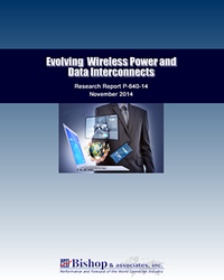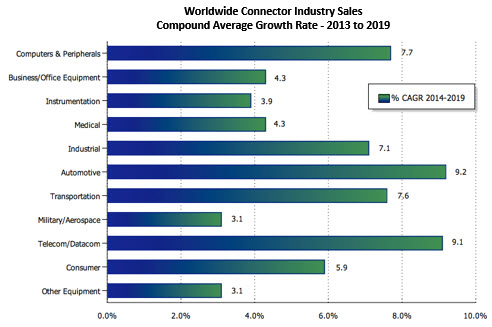Evolving Wireless Power and Data Interconnects
| Report Number: P-640-14 |
Price:
$3575.00
|
| Publication Date: November 2014 |

This is invisible
Evolving Wireless Power and Data Interconnects

What effect will the growing use of wireless and contactless connectivity have on the traditional connector market and what opportunities will this technology provide designers of electronic products?
The explosive market for mobile devices has begun to change the paradigm of connectivity with demand for interfaces that free the device from the tether of signal and power cables. A host of both short and long range wireless connectivity standards such as Wi-Fi, Bluetooth and RFID offer wireless links that are effectively replacing traditional connectors on an expanding universe of remote and mobile devices. At the same time, wireless charging technology offers the convenience of consumer-friendly battery charging while eliminating the need for a power connector on the device.
As more electronic devices become mobile, the implications for standard copper interfaces continue to grow. The expanding array of wireless interconnection options is providing new challenges and opportunities for designers of electronic devices as well as connector manufacturers.
So, how will wireless and contactless connectivity effect the traditional connector market? What are the implications on copper and fiber interconnects as we know them today? Bishop’s new report – Evolving Wireless Power and Data Interconnects – discusses these issues and more, as the demand for wireless alternatives races ahead.
This report examines:
- The basic characteristics of wireless and contactless technology, reviewing advantages and limitations along with examples of typical applications where the technology has been implemented.
- The effect contactless interconnects can have on data rates and system packaging.
- The use of millimeter wave transmission as a possible solution to the looming shortage of available frequency bands.
- Which market sectors will benefit most from wireless and contactless connectivity and will the Internet of Things spur the evolution of this technology?
This is invisible
Chapter 1 – Report Scope and Methodology
- Report Objectives
- Report Methodology and Approach
- Executive Summary
Chapter 2 – Separable Interface Technology
- Evolution of Copper Interconnects
- Common Types of Copper Connectors
- Typical Applications / Packaging Levels
- Advantages and Limitations of Copper Connectors in High-Speed Applications
- Market Demand for Alternative Interfaces
Chapter 3 – Wireless Data Interconnects
- Wireless Data vs. Energy Transfer Technology
- Electromagnetic Spectrum
- Wireless Data Communication
- Free-Space Optical Links
- Radio Frequency Identification (RFID)
- RFID Bands and Applications
- Near Field Communication
- Low-Power / Short Range RF Data Links
- ZigBee
- Bluetooth
- Certified Wireless USB
- Z-Wave
- High-Speed Wireless Data Links
- Wi-Fi
- Wi-Fi Direct
- WiMAX
- Typical Short Range Wireless Applications / limitations
- The Role of Wireless Standards Organizations
Chapter 4 – Millimeter Wave Interconnect Technology
- 60 GHz Transmission Technology
Chapter 5 – Ultra Short Range Data Links
- Contactless Connector Technology
- TransferJet
- ARISO Connector Platform
- Balluff Non-Contact Connectors
- B&PLUS Non-Contact Connectors
- Keyssa Wireless Interconnect
Chapter 6 – Market Values and Forecasts
- Defining the Market Values of Contactless Connectors
- Overall Connector Market Value
- Marketing Opportunities for Wireless Interconnect
- Bluetooth Sales
- Wireless Charging Product Sales
- Worldwide Market for Industrial Connectors
- Worldwide Market for Industrial Contactless Connectors 2013 – 2019
- Mobile Computer and Cellphone Connector Sales 2013-2019
- Mobile Computer, Cellphone & Docking Device EHF-CC Sales 2013 – 2019
Chapter 7 – Major Findings and Conclusions
Appendix A – Terms and Definitions
This is invisible
Evolving Wireless Power and Data Interconnects

This seven chapter report provides a detailed analysis of the Wireless Power and Data Interconnect Market. The report covers connector sales data for the years 2014 through 2019 by appropriate wireless technology and market sector. Forecasts are also broken out in some sectors by sub-sector.
Separable copper connectors have provided the mechanism for assembly and operation of electronic devices that have changed our world. Connectors have evolved to meet the sometimes conflicting series of packaging and performance challenges including higher:
- Pin counts
- Signal density
- Current density
- Signal speeds
- Mechanical durability
- Signal integrity
- Environmental resistance
All at a lower cost and delivered in a highly competitive global market.
The explosive market for mobile devices has begun to change the paradigm of connectivity with demand for interfaces that free the device from the tether of signal and power cables. A host of both short and long range wireless connectivity standards such as Wi-Fi, Bluetooth and RFID offer wireless links are effectively replacing traditional connectors on an expanding universe of remote and mobile devices. At the same time, wireless charging technology offers the convenience of consumer-friendly battery charging while eliminating the need for a power connector on the device.
As more electronic devices become mobile, the implications for standard copper interfaces continue to grow. The expanding array of wireless interconnection options is providing new challenges and opportunities for designers of electronic devices as well as connector manufacturers.
This market research report explores the evolution of input/output links both copper and wireless. From a system perspective, an I/O or power link can be a traditional connector and cable assembly or a wireless connection that serves the same function. The length of the link can vary from a few centimeters to miles which illustrates one of the advantages of wireless communication. Wireless link technology can be used to communicate between remote devices as well as be configured to replace copper pins and sockets in traditional connector applications. The establishment of the I/O and power link is invisible to the consumer which supports the user-friendly mandate.
At this point, the impact of wireless interconnects on traditional connectors has been muted due to the fact that introduction of wireless technology typically requires the establishment of infrastructure to support it. Equipment such as cell phone towers, switches and wireless routers typically utilize traditional connectors that compensate for the elimination of a connector on the mobile or remote device. Traditional copper connector sales are projected to show solid growth over the five years.

Of interest is the fact that many of the fastest growing product segments including industrial control, home automation, wearable electronics, and smart phone applications incorporate remote communication, making wireless data and power interconnect technology a key design consideration. The Internet-of-Things is expected to stimulate a host of new wireless connected devices.
This market research report explores each of the leading wireless power and data transmission technologies in terms of performance, supporting organizations / standards, as well as target applications.
Special emphasis is placed on emerging technologies such as millimeter wave transmission which is anticipated to be a possible solution to the looming shortage of available frequency bands. Unlike most wireless radio technologies, the specific characteristics of millimeter wave links lend themselves to point-to-point links that can directly eliminate a copper connector while offering high-speed communication through a dielectric surface. These connectors can offer nearly unlimited mechanical durability, zero mating forces, environmentally sealed device enclosures and freedom from contact damage.
Wireless connectivity will never replace traditional copper interfaces, but represents a growing market segment that in addition to fiber optic links, offers new options to designers of electronic products.
Download a descriptive brochure here



